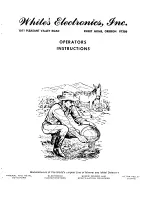
GROUND ADJUSTMENT CHART
If bars or in Auto-Tune
appear pumping coil sounds like then
AT TOP
PUSHING SOUND
OUT OF GROUND DECREASE THE GROUND SETTING
AT BOTTOM
PULLING SOUND
INTO GROUND INCREASE THE GROUND SETTING
SAME SOUND NO
NO BARS WHEN RAISING ADJUSTMENT
AND LOWERING NECESSARY
AT BOTTOM
AT TOP
GROUND ERROR
(continued)
21
* When the detector’s internal Ground Setting is lower than the actual
phase of the ground, the bars on the
bottom
of the graph will be
illuminated. The bigger the error is, the more bars will show up.
* If the Ground Error
exceeds the level of three bars
,
or
will appear,
indicating the maximum error has been reached, and action must be taken
to adjust the Ground Setting.
To maintain maximum detector performance, keep the Ground Error to a
minimum by adjusting the Ground Setting.
Before making an adjustment, it is best to verify the Ground Error as follows:
1. Place the detector into All Metal Mode.
2. Pump the searchcoil up and down over
a patch of ground free of metal,
repeatedly moving the coil to within 1” of the ground and lifting it up about
6” over the ground.
If bars appear at the top of the graph, manually
adjust
the Ground Setting
negatively until all of the bars disappear. If bars appear at the bottom of the
graph, manually
adjust
the Ground Setting positively until all of the bars
disappear.
While in ALL METAL Mode, pumping the searchcoil over the ground, you will
also hear audible evidence of an out-of-adjustment Ground Setting. If the
Ground Setting is too low, there will be a difference in the sound as the
searchcoil
is moving away
from the ground. It will sound like you are pulling
the sound out of the ground. If the Ground setting is too high, it will sound like
you are pushing the sound into the ground.
• If the sound is louder as you raise the searchcoil, manually adjust the
ground setting to increase the ground balance setting.
• If the sound is louder as you lower the searchcoil, manually adjust the
ground setting to reduce the ground balance setting.








































